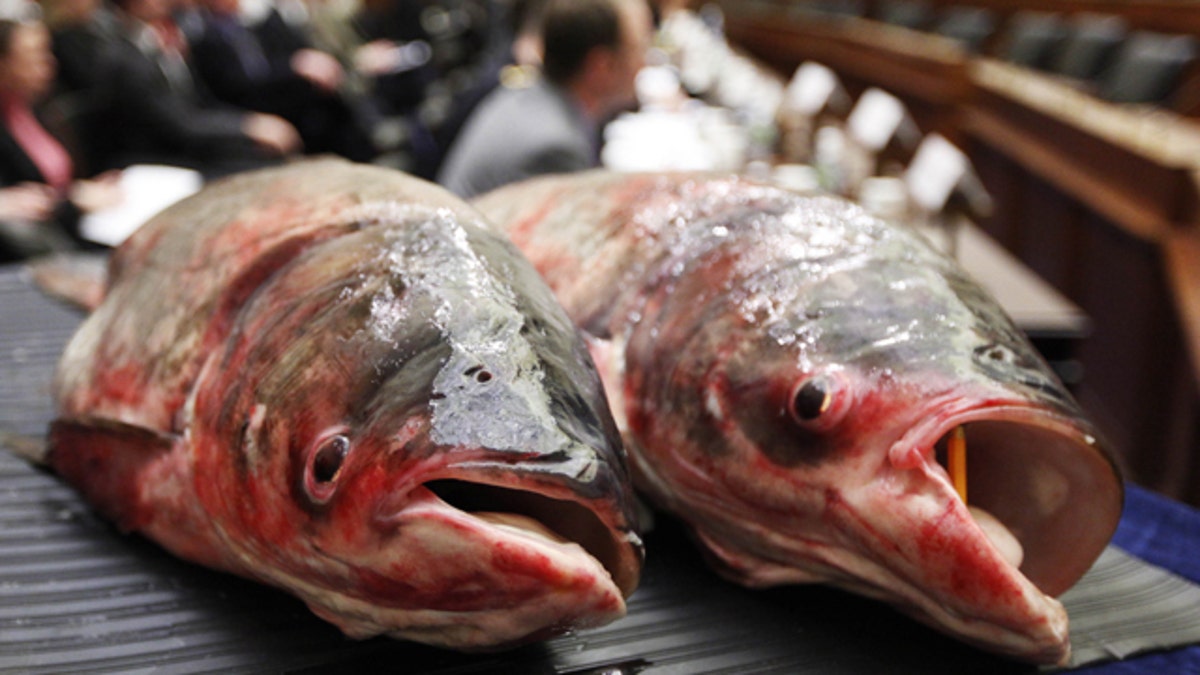
State and federal agencies are at war with the Asian carp, an invasive fish species that can grow up to five feet and weigh more than a hundred pounds. (AP)
The Great Lakes are under the threat of invasion by a foreign species — and the debate is raging on how it can be prevented.
State and federal agencies are at war with the Asian carp, an invasive fish species that can grow to lengths of up to five feet and weigh more than a hundred pounds.
“Once an invasive species is established, it's really, really hard to eradicate,” said Roger Germann, executive vice president of Chicago’s Shedd Aquarium.
With no natural predators and insatiable appetites, Asian carp can eradicate entire fish populations by consuming nearly all of the available plankton, which are the primary food source for most fish.
Asian carp have slowly worked their way up the Mississippi River over the last 40 years after being brought to the United States from Asia in the 1970s to help get rid of algae on catfish farms and wastewater treatment ponds. In recent years, however, the carp have been found in northern parts of the Illinois River, about 40 miles southwest of Lake Michigan.
If Asian carp reach there, researchers say the entire ecosystem of the Great Lakes could be devastated, including the region’s $7 billion annual fishing industry.
"This is a national treasure that we have and it's worth keeping,” said Grand Rapids (Mich.) Mayor George Heartwell. “It's 20% of the surface fresh water on the globe right here. We're the stewards of it and it's at risk right now."
With the invasive species on the doorstep of the Great Lakes, officials have tried a wide variety of measures to keep the fish away: water cannons that create turbulence in the river; chemical toxins; hiring commercial fisherman; and even electric fishing.
"We've taken over 2.1 million pounds since 2010,” said Kevin Irons of Illinois' Department of Natural Resources. “We've taken as many as 80,000 or 100,000 pounds in a given week."
But the Army Corps of Engineers, Heartwell and other mayors in the Great Lakes and St. Lawrence Cities Initiative say those methods — along with a series of underwater electric barriers in the Illinois River — still aren’t doing enough to completely protect the Great Lakes from Asian carp.
After two years of research, the Army Corps of Engineers earlier this year presented lawmakers with eight potential plans for protecting the Lakes. The proposal that’s received the most attention would physically cut-off Lake Michigan from Chicago’s waterways with a series of permanent barriers. Heartwell and others say that $18 billion plan, which is expected to take 25 years to complete, has the best shot at protecting the Lakes.
"It's not inexpensive but it's a solution," Heartwell said. "The risk of course of not doing it is that we have a multi-billion dollar sports fishing and tourism industry that would be devastated here in the Great Lakes."
Critics of the plan though say it’s too expensive, too slow, and isn’t guaranteed to keep Asian carp from reaching the Great Lakes.
“The permanent barrier, depending on how simple it is or how massive it is, may not take into account some of the other waterways boats can get in,” Germann said. “It may not take into account a hundred-year flood that happens. So, I'm not sure that that's ultimately even at the end of the day, the permanent solution."
Chicago’s waterways are also key shipping routes for businesses to easily ship goods from the Great Lakes, down the Mississippi River, and into the Gulf of Mexico. Permanent barriers would cost commercial shippers more than $200 million per year, according to the report.
There's no specific timeline for Congress to take action and any decision could still be a few years away, meaning Asian carp could still have a few more years to reach the Great Lakes.